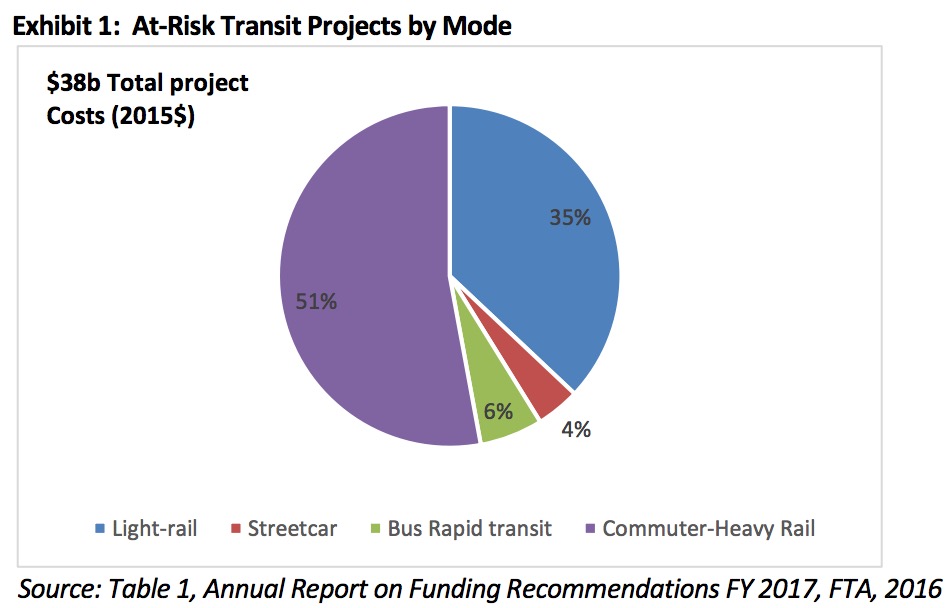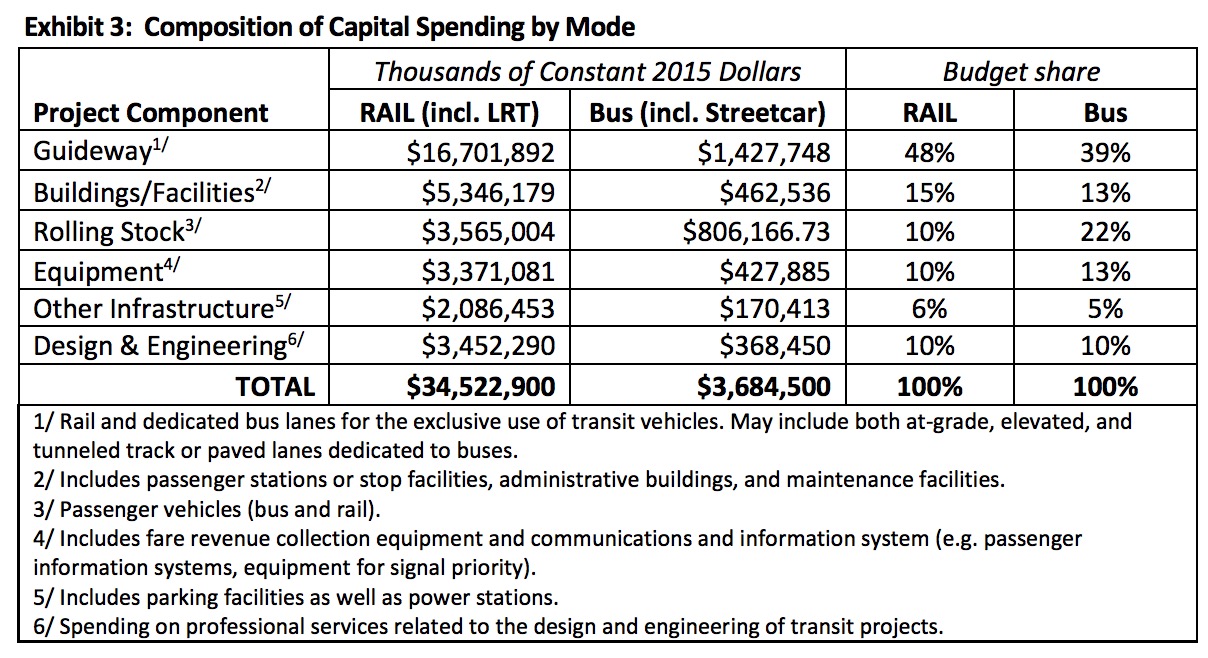American Public Transportation Association (APTA)
Key Findings
- The Administration’s proposed funding cuts for transit capital projects would jeopardize $38 billion of planned projects. These projects would support 502,000 jobs within the span of constructing these projects — representing project construction jobs, transit equipment manufacturing jobs and wider multiplier effects on jobs associated with parts & materials suppliers and worker re-spending. The time span for completion of these projects vary, but overall, they would be completed over a period of slightly more than ten years, representing an annual average of 49,000 jobs supported each year over that period.
- A possible loss of $90 billion in economic output due to the reduced hard-hat employment and their associated spending.
- After the capital spending is finished and new transit lines are operational, there would also be ongoing, permanent economic growth and development impacts enabled by the transportation improvements and associated economic productivity gains. Based on a review of past transit studies, it is likely that impacts of the completed projects would grow to over time to a level of 300,000 or more jobs added in the affected regions.
- The jobs generated by construction spending effects would occur during the years in which construction takes place, and end when the projects are completed. The economic development effects would start once the projects are completed and transit services open, leading to cumulative job growth over time that would reach the estimated levels 10-20 years after projects are completed.
Background
 The proposed Federal Budget would affect nearly $40 billion of transit capital projects across the country that have yet to get either a full funding or small starts grant agreement in place (see Appendix A). The proposed budget would immediately remove $20 billion from the Capital Improvement Grants program offered through the Federal Transit Administration – roughly 50 percent of the total project costs associated with 53 now “at-risk” projects. 1 (see Exhibit 1.)
The proposed Federal Budget would affect nearly $40 billion of transit capital projects across the country that have yet to get either a full funding or small starts grant agreement in place (see Appendix A). The proposed budget would immediately remove $20 billion from the Capital Improvement Grants program offered through the Federal Transit Administration – roughly 50 percent of the total project costs associated with 53 now “at-risk” projects. 1 (see Exhibit 1.)
The national economic impacts of indefinitely postponing these projects’ federal funding is based on the premise that without the planned federal funding, these projects would have too large a funding shortfall to proceed. That assumes that local agency project sponsors would be facing a substantial hurdle to replace the planned federal contribution. Exhibit 2 lists the types of “at risk” transit projects.
 Capital Funding Shortfall Impact
Capital Funding Shortfall Impact
There are three ways to view job impacts of the federal transit funding loss.
- The first is to calculate the loss of construction, manufacturing and other related jobs associated with the planned capital spending.
- The second is to calculate the foregone long-term economic development effects that would otherwise be expected to occur if these projects had occurred as planned.
- The third is to consider the net difference between job creation associated with public transportation investment and job creation associated with alternative use of the same federal funds for defense spending.
This study addresses all three issues.
Loss of Investment Spending
To calculate the lost jobs associated with federal transit capital matching funds, we examined the mix of spending associated with new start projects in the funding queue. Most projects would require some expenditure for rolling stock for example, but not all. Some would add a few stations, while others may not. Some would expend to build parking capacity for riders, others would construct power substations for power conversion projects or new electrified services. Given the range of mode types within the list, we relied upon the Bureau of Transportation Statistics National Transit Database 2014, for the allocation of capital outlays by the four categories in Exhibit 2 (note that we used an average of the shares for commuter and heavy rail categories). Exhibit 3 then condenses the project list into two basic categories – rail and bus.

Using a national IMPLAN input-output model (2015), NAICS-sector mapping and assumptions on the local purchase coefficients (LPC’s) on key categories2 consistent with the 2014 APTA Economic Impact Update report, Exhibit 4 shows the job, labor income and value-added implications across the construction interval. Exhibit 5 presents the average annual impact for various metrics.
Foregone Long-term Economic Development Impacts
Besides short-term impacts of foregone construction activities and equipment purchases, there are longer-term impacts of foregone regional economic growth and development associated with transit investments. These are jobs generated by additional economic growth occurring as a result of enhanced productivity in the economy, including effects of improved labor market access and traffic congestion reduction with improved travel time reliability. (These jobs are over and above those supported by added spending on transit operations.)
There is a history of ex-post studies that have documented actual impacts of major transit lines, and ex-ante studies that have calculated the projected impacts of planned lines. We reviewed those studies, and examined the mix of 53 currently proposed transit investment projects awaiting federal matching funds. Based on that analysis, we identified the likely range of long term economic development impacts.
From a subset of transit projects which we investigated among this list of at-risk project proposals and others projects’ literature, there is a propensity to attract additional ridership and generate benefits for them, their employers, and the retail stores or restaurants they travel to. The associated effect is roughly between 10 and 20 additional daily riders per invested million dollars invested. This range can be considerably higher for BRT projects.
Additionally, the long term economic development impact from major transit projects can be assessed in terms of the expected number of additional jobs generated as a result of completing those projects. The subset of transit studies that were reviewed demonstrated long term impacts on their regional economies, averaging between 8 and 20 jobs per million dollars invested. Using the low-end of this range, the total number permanent jobs generated by the $38 billion of transit investment would be expected to grow over time, and exceed 300,000 more jobs than would exist without those investments. The additional job growth would be expected to occur over a period of 10-20 years after these projects are constructed and operational.
Comparison to National Impacts related to Defense Spending
We make no comment on the inherent value of national security. The 2014 APTA Economic Impact Update report (in Exhibit 4-4) cited ‘total job impacts per $1 billion of outlay’ for various alternative uses of federal monies. Federal defense spending was associated with 8,555 total jobs per $1 billion based on a 2007 study from UMASS-Amherst, PERI. A more recent study of federal defense outlays3 shows 5,467 total jobs per $1 billion for 2018 when a $30 billion envisioned cut was under consideration with the Budget Control Act of 2011. This compares to what is implied in Exhibit 4 for combined transit projects at-risk – namely 13,160 total jobs per $1 billion of transit capital outlay.
The difference between the 2012 and 2007 study results on defense outlay stimulus is explained by different wages and productivity in the national economy, different modeling approaches, and different composition of defense outlays.
About the American Public Transportation Association (APTA)
www.apta.com
APTA is the leading force in advancing public transportation. To strengthen and improve public transportation, APTA serves and leads its diverse membership through advocacy, innovation and information sharing. APTA and its members and staff work to ensure that public transportation is available and accessible for all Americans in communities across the country
Tags: American Public Transportation Association, APTA, President Trump, public transit, Trump Administration






 RSS Feed
RSS Feed